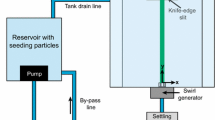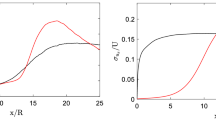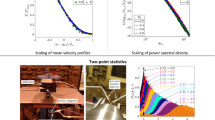Abstract
Flow structures that cause destruction of the Reynolds (shear) stress are investigated by means of simultaneous measurement of the velocity gradient and pressure. Two types of combined probes are used for the simultaneous measurement of the velocity gradient and pressure. One consists of an X-type hot-wire probe and a pressure probe; another consists of two I-type hot-wire probes arranged in parallel with a small vertical separation (double-I) and a pressure probe. The hot-wire probe and the pressure probe are aligned along the streamwise direction for both combined probes. We confirm that the simultaneous measurement of the velocity gradient and pressure in a plane jet is satisfactorily performed using the combined probes, except for the outside of the velocity half-width. In a plane jet, \(\overline{(p'/\rho )(\partial u'_{2}/\partial x_{1})}\) does not contribute to the Reynolds stress destruction, so that the total pressure-rate-of-strain correlation is almost equal to \(\overline{(p'/\rho )(\partial u'_{1}/\partial x_{2})}\). The flow structures that destruct the Reynolds stress are extracted by the conditional sampling technique. We find two structures, which support the thought experiment conducted by Hinze (Turbulence, 2nd edn, McGraw-Hill College, Pennsylvania, 1975). The structures are concentrated around large-scale vortex structures, which cause strong momentum transfer. The scale of the structures is intermediate: smaller than large-scale motion contributing to the momentum transfer, and larger than small-scale motion contributing to the energy dissipation.
Graphical abstract



















Similar content being viewed by others
References
Antonia RA, Prabhu A (1976) Reynolds shear stress and heat flux balance in a turbulent round jet. AIAA J 14(2):221–228. https://doi.org/10.2514/3.7073
Antonia RA, Browne LWB, Rajagopalan S, Chambers AJ (1983) On the organized motion of a turbulent plane jet. J Fluid Mech 134:49–66. https://doi.org/10.1017/S0022112083003213
Antonia RA, Zhu Y, Kim J (1993) On the measurement of lateral velocity derivatives in turbulent flows. Exp Fluids 15(1):65–69. https://doi.org/10.1007/BF00195597
Blackwelder RF, Kaplan RE (1976) On the wall structure of the turbulent boundary layer. J Fluid Mech 76:89–112. https://doi.org/10.1017/S0022112076003145
Burattini P, Antonia RA, Danaila L (2005) Similarity in the far field of a turbulent round jet. Phys Fluids 17(025):101. https://doi.org/10.1063/1.1833414
Cadot O, Douady S, Couder Y (1995) Characterization of the low-pressure filaments in a three-dimensional turbulent shear flow. Phy Fluids 7(3):630–646. https://doi.org/10.1063/1.868586
Dennis DJC, Nickels TB (2011) Experimental measurement of large-scale three-dimensional structures in a turbulent boundary layer. Part 1. Vortex packets. J Fluid Mech 673:180–217. https://doi.org/10.1017/S0022112010006324
Djenidi L, Antonia RA, Lefeuvre N, Lemay J (2016) Complete self-preservation on the axis of a turbulent round jet. J Fluid Mech 790:57–70. https://doi.org/10.1017/jfm.2015.761
Durbin PA (2018) Some recent developments in turbulence closure modeling. Annu Rev Fluid Mech 50:77–103. https://doi.org/10.1146/annurev-fluid-122316-045020
Everitt KW, Robins AG (1978) The development and structure of turbulent plane jets. J Fluid Mech 88(3):563–583. https://doi.org/10.1017/S0022112078002281
Fukagata K, Kobayashi M, Kasagi N (2010) On the friction drag reduction effect by a control of large-scale turbulent structures. J Fluid Sci Technol 5(3):574–584. https://doi.org/10.1299/jfst.5.574
Ganapathisubramani B, Lakshminarasimhan K, Clemens NT (2008) Investigation of three-dimensional structure of fine scales in a turbulent jet by using cinematographic stereoscopic particle image velocimetry. J Fluid Mech 598:141–175. https://doi.org/10.1017/S0022112007009706
Gibson MM, Launder BE (1978) Ground effects on pressure fluctuations in the atmospheric boundary layer. J Fluid Mech 86(3):491–511. https://doi.org/10.1017/S0022112078001251
Hinze JO (1975) Turbulence, 2nd edn. McGraw-Hill College, Pennsylvania
Hussain AKMF, Zaman KB (1985) An experimental study of organized motions in the turbulent plane mixing layer. J Fluid Mech 159:85–104. https://doi.org/10.1017/S0022112085003111
Iida O, Iwatsuki M, Nagano Y (2000) Vortical turbulence structure and transport mechanism in a homogeneous shear flow. Phys Fluids 12(11):2895–2905. https://doi.org/10.1063/1.1311613
Jones WP, Musonge P (1988) Closure of the Reynolds stress and scalar flux equations. Phys Fluids 31(12):3589–3604. https://doi.org/10.1063/1.866876
Kahalerras H, Malécot Y, Gagne Y, Castaing B (1998) Intermittency and Reynolds number. Phys Fluids 10(4):910–921. https://doi.org/10.1063/1.869613
Kaimal JC, Finnigan JJ (1994) Atmospheric boundary layer flows: their structure and measurement. Oxford University Press, Oxford
Kasagi N, Sumitani Y, Suzuki Y, Iida O (1995) Kinematics of the quasi-coherent vortical structure in near-wall turbulence. Int J Heat Fluid Flow 16(1):2–10. https://doi.org/10.1016/0142-727X(94)00006-X
Kawata T, Naka Y, Obi S (2014) Simultaneous measurement of fluctuating velocity and pressure in the near wake of a circular cylinder. Exp Fluids 55:1731. https://doi.org/10.1007/s00348-014-1731-7
Lai CCK, Socolofsky SA (2018) Budgets of turbulent kinetic energy, Reynolds stresses, and dissipation in a turbulent round jet discharged into a stagnant ambient. Environ Fluid Mech 18:1–29. https://doi.org/10.1007/s10652-018-9627-3
Lumley JL (1975) Pressure-strain correlation. Phys Fluids 18(6):750. https://doi.org/10.1063/1.861205
Mansour NN, Kim J, Moin P (1988) Reynolds-stress and dissipation-rate budgets in a turbulent channel flow. J Fluid Mech 194:15–44. https://doi.org/10.1017/S0022112088002885
Nagano Y, Tagawa M (1995) Coherent motions and heat transfer in a wall turbulent shear flow. J Fluid Mech 305:127–157. https://doi.org/10.1017/S0022112095004575
Naka Y, Omori T, Obi S, Masuda S (2006) Simultaneous measurements of fluctuating velocity and pressure in a turbulent mixing layer. Int J Heat Fluid Flow 27:737–746. https://doi.org/10.1016/j.ijheatfluidflow.2006.02.023
Oler JW, Goldschmidt VW (1981) Coherent structures in the similarity region of two-dimensional turbulent jets. J Fluids Eng 106(2):187–192. https://doi.org/10.1115/1.3243097
Rogers MM, Moser RD (1994) Direct simulation of a self-similar turbulent mixing layer. Phys Fluids 6(2):903–923. https://doi.org/10.1063/1.868325
Sakai Y, Moriguchi Y, Tanaka N, Yamamoto M, Kubo T, Nagata K (2007) On characteristics of velocity and pressure field in two-dimensional turbulent jet. J Fluid Sci Technol 2(3):611–622. https://doi.org/10.1299/jfst.2.611
Speziale CG, Sarkar S, Gatski TB (1991) Modelling the pressure-strain correlation of turbulence: an invariant dynamical systems approach. J Fluid Mech 227:245. https://doi.org/10.1017/S0022112091000101
Tennekes H, Lumley JL (1972) A first course in turbulence. MIT Press, London
Terashima O, Sakai Y, Nagata K (2012) Simultaneous measurement of velocity and pressure in a plane jet: development of well-arranged combined probe and estimation of turbulent energy budget. Exp Fluids 53(4):1149–1164. https://doi.org/10.1007/s00348-012-1351-z
Terashima O, Onishi K, Sakai Y, Nagata K, Ito Y (2014a) Simultaneous measurement of all three velocity components and pressure in a plane jet. Meas Sci Technol 25:5. https://doi.org/10.1088/0957-0233/25/5/055301
Terashima O, Sakai Y, Nagata K, Ito Y, Onishi K (2014b) Experimental verification of the turbulence models for the pressure diffusion process in a turbulent plane jet. Int J Mech Sci 89:12–20. https://doi.org/10.1016/j.ijmecsci.2014.08.015
Terashima O, Sakai Y, Goto Y, Onishi K, Nagata K, Ito Y (2015a) On the turbulent energy transport related to the coherent structures in a planar jet. Exp Therm Fluid Sci 68:697–710. https://doi.org/10.1016/j.expthermflusci.2015.07.009
Terashima O, Sakai Y, Nagata K, Ito Y, Onishi K, Shoji Y (2015b) On the velocity and pressure statistics during the flapping motion in a planar turbulent jet. Int J Heat Fluid Flow 53:56–67. https://doi.org/10.1016/j.ijheatfluidflow.2015.01.007
Tsuji Y, Kaneda Y (2012) Anisotropic pressure correlation spectra in turbulent shear flow. J Fluid Mech 694:50–77. https://doi.org/10.1017/jfm.2011.502
Acknowledgements
We express our gratitude to Mr. Satoru Nakamura for his help with our experiments. The present study was partially supported by the Grants-in-Aid for Scientific Research (nos. 15K17969 and 18H01369).
Author information
Authors and Affiliations
Corresponding author
Additional information
Publisher's Note
Springer Nature remains neutral with regard to jurisdictional claims in published maps and institutional affiliations
Evaluation of the error due to the disagreement of the measurement points of velocity gradient and pressure
Evaluation of the error due to the disagreement of the measurement points of velocity gradient and pressure
For the present combined probes, the measurement point of the velocity gradient is 2.9 mm upstream of that of the pressure. In this study, the disagreement of the measurement points is corrected by shifting the measured signal in the streamwise direction after the time–space conversion. This appendix evaluates the error caused by measuring the velocity gradient and the pressure at the different points.
There are two requirements to correct the disagreement of the measurement points by time–space conversion (regardless of TH base or MTH base) and by shifting the measured signal:
-
1.
The turbulent structure is frozen during traveling from the velocity measurement point to the pressure measurement point.
-
2.
The turbulent structure is convected only in the streamwise direction.
(1) It may not be satisfied by small-scale structures, because their timescales are so small that the structures can be easily deformed during the traveling. (2) It is not realized due to the three-dimensional fluctuation of the convection velocity, especially when the relative turbulence intensity is large just like the present plane jet.
First, let us estimate the scale at which the structures can be regarded to be frozen. Here, we consider to correct the result at \(x_{2}/b_{u}=0.8\) using the time–space conversion based on the TH in Eq. (1); that is, we use the unique convection velocity \(U_{co}=U_{1}=3.2\) m/s. A structure measured by the hot-wire probe reaches the pressure measurement point after “traveling time", \(2.9\times 10^{-3}/3.2=9.0\times 10^{-4}\) s. The timescale of the structure must be sufficiently larger than the traveling time, so that the structure is frozen during the traveling.
The timescale \(\tau\) of the turbulent structure at \(k_{1}\) is estimated to be (Tennekes and Lumley 1972, p. 260):
Kolmogorov scaling \(E_{11}\propto \varepsilon ^{2/3}k_{1}^{-5/3}\) gives \(\tau \sim \varepsilon ^{-1/3}k_{1}^{-2/3}\).
Here, we evaluate two timescale at \(k_{1}\eta =1\) (Kolmogorov timescale) and \(k_{1}\eta =0.1\). The Kolmogorov timescale is specifically \(8.63\times 10^{-4}\) s, which is almost the same as the traveling time. Therefore, the smallest turbulent structures cannot be measured even if the present correction is performed, because they can be deformed during the traveling. On the other hand, the specific timescale for \(k_{1}\eta =0.1\) is \(\tau =4.5\times 10^{-3}\) s, which is considerably larger than the traveling time. This indicates that, at least, the structures in \(k_{1}\eta \le 0.1\) are almost frozen during the traveling from the X probe to the pressure probe.
Second, we discuss the influence of fluctuation of the convection velocity. The fluctuation of the convection velocity in the streamwise direction can be corrected by use of the MTH (Kahalerras et al. 1998; Burattini et al. 2005; Djenidi et al. 2016), but the fluctuation in the cross-streamwise and spanwise directions cannot. However, the error caused by the fluctuation in the vertical direction is expected to be no more than the error by the fluctuation in the streamwise direction because of \(u'_{1,\text {rms}}>u'_{2,\text {rms}}\) in the plane jet.
The influence the fluctuation of the convection velocity is checked by comparison of cospectra \(C_{p/\rho ,\partial u_{2}/\partial x_{1}}(k_{1})\): one is corrected based on TH (Eq. 1) and the other is based on MTH (Eq. 2). The discrepancy between the two cospectra is the influence of the fluctuation of the convection velocity in the streamwise direction. Figure 19 shows \(C_{p/\rho ,\partial u_{2}/\partial x_{1}}(k_{1})\) at \(x_{1}/h=40\), \(x_{2}/b_{u}=0.8\). The \(C_{p/\rho ,\partial u_{2}/\partial x_{1}}(k_{1})\) without any correction is also included in Fig. 19 for reference. The cospectrum corrected by the MTH is almost the same as that by TH. We can confirm that the error in measuring \(\overline{(p'/\rho )(\partial u'_{1}/\partial x_{2})}\) due to the fluctuation of the convection velocity is actually small.
Rights and permissions
About this article
Cite this article
Takahashi, M., Iwano, K., Sakai, Y. et al. Experimental investigation on destruction of Reynolds stress in a plane jet. Exp Fluids 60, 46 (2019). https://doi.org/10.1007/s00348-019-2691-8
Received:
Revised:
Accepted:
Published:
DOI: https://doi.org/10.1007/s00348-019-2691-8





